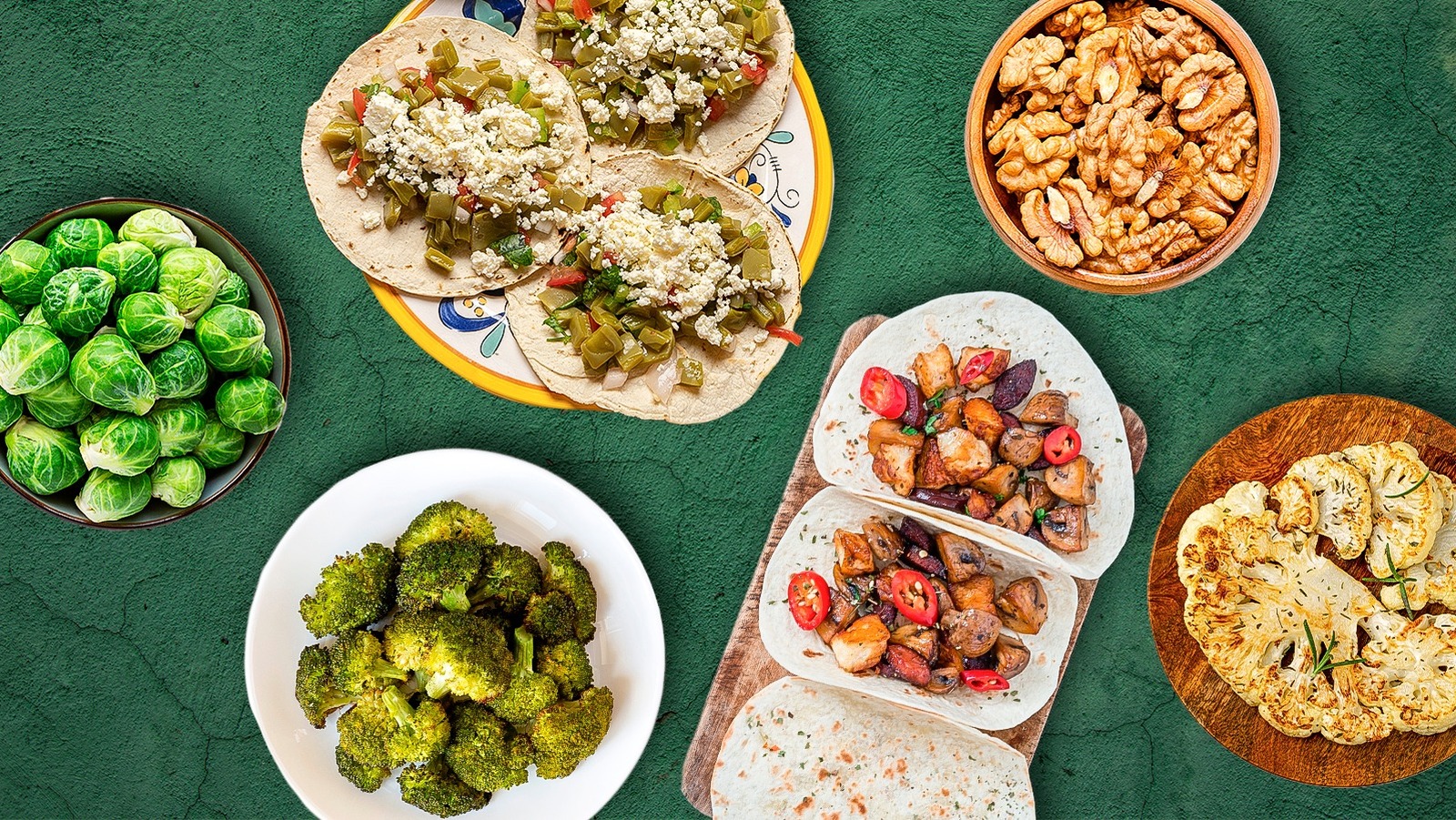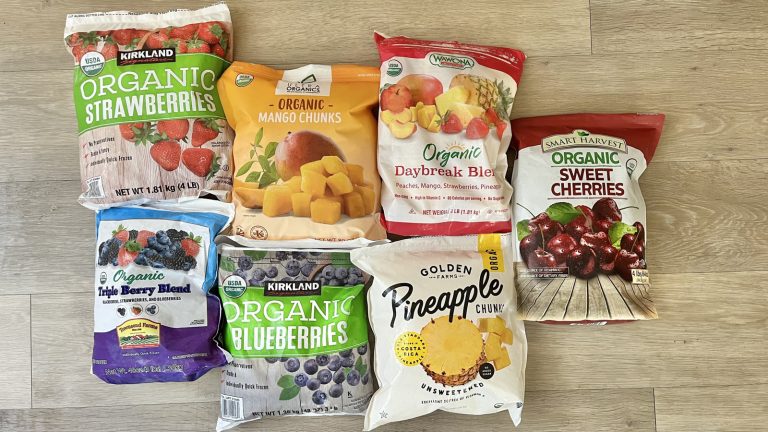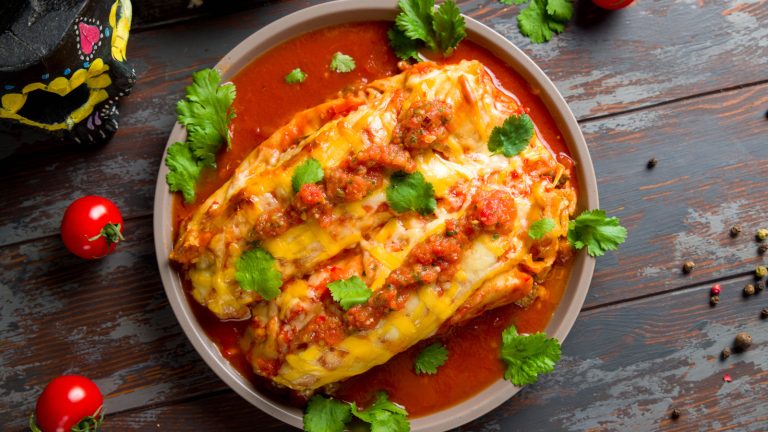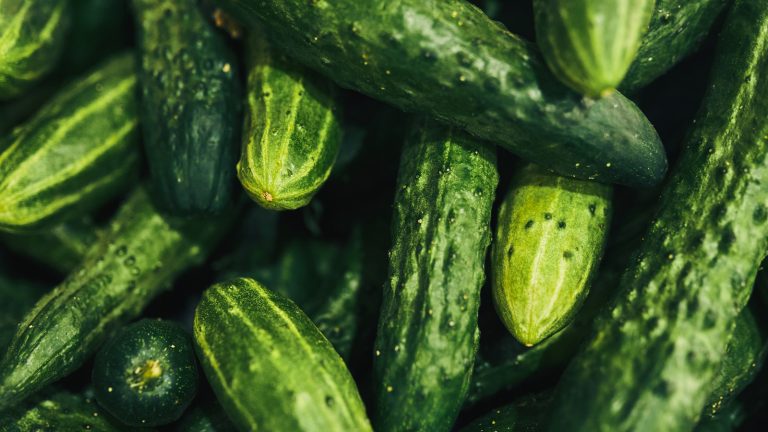We may receive a commission on purchases made from links.
Whether you’re a vegetarian or a meat lover, it’s essential to know your way around a veggie taco. While a nice carnitas or beef taco can be classic, the world of vegetables is much more expansive, and flexing your culinary creativity is always important. Now, everyone and their brother has had black bean tacos before, and there are endless ways to spice them. However, it’s time to dive headfirst into the world of vegetarian taco fillings and enjoy endless flavors and textures. Yes, you can still add your black beans in, too.
While some of these tasty vegetarian taco fillings, other than beans, are meant to resemble meat, others shine through as their own star ingredient. It’s so easy to get pulled into making meat alternatives, which can be delicious, but it’s also important to enjoy all of nature’s bounty for what it offers as a plant. As a Plant-Based Chef and Recipe Designer, I actually find that meat-lovers are less hesitant to try a vegetable dish when it’s not supposed to resemble meat, and are more satisfied with the outcome because there is no comparison to be made. There are some pretty spot-on alternatives that bring an element of familiarity to the table for those not self-identified as experimental eaters (yet, anyway). The most important aspect of a vegetarian taco is finding a solid, flavorful base that stands in for beans or meat. It must be powerfully spiced, and it must leave a lasting impression.
Walnuts
If you’re looking for a melt-in-your-mouth yet chewy base for your tacos, then look no further than walnuts. It’s likely you have some in your pantry as we speak. Walnuts are the absolute best beef swap for the ultimate vegan tacos, as Tabitha Brown uses them herself. She also suggests pecans, because they both have that dense and fatty mouthfeel, similar to beef, while providing a nice neutral flavor. Of course, with any taco base, it’s important to use strong spices and a lot of them. The biggest mistake you can make is underspicing your base ingredient, whether it’s a meat, fruit, or vegetable.
To prepare the walnuts, toss them in the food processor and give them a nice chop. They should start to look like the consistency of ground beef. This is a good opportunity to mix in your spices like garlic powder, onion powder, paprika, pepper, chili, and some tamari or soy sauce. You can also use an enchilada sauce and simmer your walnuts on the stovetop for a simpler seasoning. Let that liquid cook off, and enjoy a protein-rich, cholesterol-free alternative to beef.
Pulled Jackfruit
Unless you’re deep in the world of vegetarianism or from a tropical climate, it’s likely you’ve never heard of jackfruit. Yes, now and again, it will pop up in the produce section of grocery stores, typically pre-cut because it’s so massive, or hiding with the canned foods. But if it’s not ringing a bell, you’re not alone. Jackfruit is a large, heavy, spikey, starchy fruit that has a slightly sweet yet neutral flavor. It has a similar consistency to a dry and rubbery pineapple, with long strands that can be pulled apart, resembling pulled pork.
I recommend buying unsweetened canned jackfruit, as it’s much easier to work with and more likely to be carried at your grocery store. Although cooking with jackfruit is easy, prepping the whole fruit can be laborious, especially with that spiky outer layer. Strain your canned jackfruit, pull it apart using forks or your fingers, season it with spices or sauces, and broil it in your oven until the ends start to crisp up. I like to marinate jackfruit overnight, but even if you just toss it in some barbecue sauce, enchilada sauce, or adobe sauce right before you cook it, that should do the trick. Try pulled jackfruit tacos and enjoy a “carnitas” or “pulled chicken” taco, vegetarian style.
Roasted cauliflower
Over the last decade, cauliflower has certainly had its time in the limelight, masquerading as anything from rice to pizza crust. One of the best transformations, in my opinion, is that from cauliflower to chicken wings. Similarly, you can use cauliflower as a base for tacos. In fact, cruciferous vegetables really hold their own as a taco base, especially when seasoned properly. That crispy roasted outside, coupled with the crunchy core creates a dynamic mouthfeel. Seriously, roasted cauliflower florets are your secret for delicious veggie tacos.
The spicing secret is to go heavy on the sauce. Because cauliflower is relatively neutral, similar to white meat, you’ll need to spice it up. I like to use chipotle peppers in adobe sauce, usually canned, blended with garlic and oil which will give your cauliflower just the kick it needs. Feel free to add other herbs and spices, and even a little sweetener and some acidic lime juice to provide balance.
Lentils
There are plenty of superfoods that are often overlooked. Lentils certainly deserve some more attention, as they are loaded with fiber, protein, and other vital nutrients. They don’t taste like much but do provide wonderful texture and can be loaded up with flavor. Because lentils are fairly neutral, it’s a good idea to use a flavorful sauce or an array of intense spices. You could make your life easy by grabbing a pre-made taco seasoning packet from the grocery store, or pull together your own smoky taco seasoning recipe.
Consider using black or green lentils, as they will hold their shape as opposed to yellow or red lentils that tend to disintegrate when cooked. These chewy little pods can even resemble ground beef, although their mouthfeel is quite dissimilar. Use some tamari or soy sauce to boost the salty umami notes, and add extra virgin olive oil to balance the fat-to-starch ratio. Be sure those lentils are cooked al dente so that they are still a little chewy, while remaining whole and not crunchy. If you find them too mushy, think about using a combo of walnuts and lentils to make flavorful vegan tacos.
Mushrooms
Mushrooms are famous for replacing meat. Portobello steaks, king oyster scallops, and lion’s mane crabcakes come to mind. Mushrooms deserve a place in your tacos, as they tick all of the boxes: strong umami, chewy, savory, dense, and delicious. There are a few different mushrooms I would recommend specifically for tacos, but honestly, different types of mushroom could work if cooked and seasoned properly. Use a salty, umami marinade with plenty of spices, and let those mushrooms crisps up in your pan with hot oil.
King oyster mushrooms can be shredded to resemble pulled pork. Oyster mushrooms hold onto flavor nicely and crisps up on the ends while the stems remain juicy. Enoki mushrooms suck sauce right up and can make for a really juicy chewing experience. Shiitake mushrooms are strong with umami and are extra chewy. And lion’s mane has a unique and incredible texture that gets very crispy on its feathery ends. Even if you go with standard button mushrooms, you’re making a great decision, especially if you are trying to capture a meaty classic, because mushrooms are one of those vegan ingredients that can easily be made into a meat alternative.
Shredded tofu
Not liking tofu is an admission to not knowing how to season your food. Which is perfectly fine, as long as you’re not blaming tofu. Like chicken, tofu is just there to provide texture and hold seasonings. If you have a signature marinade or a special dry rub that always blows away your friends and family, this is the time to use it. Cubes of tofu can work in tacos, but I prefer to shred it with a cheese grater. This will give you the best texture, with the most surface area possible. Alternatively, you can crumble it.
However you prepare it, it must be saturated with flavor, and cooked until it becomes dry and chewy. Soggy tofu is another no-no that prevents people from enjoying the versatile food. Roast it in the oven, cook it on the stovetop, or toss it in your air fryer. Use plenty of oil to get those edges nice and crispy, and enjoy it stuffed into the base of your taco. Shredded tofu tacos are elite because they provide incredible texture. For best results, season your tofu with spices and oil, bake until crispy and chewy, and then simmer it in a pan with a taco sauce.
Broccoli
I tried my first roasted broccoli tacos last year, and I must have made them twice a week for the coming months because I couldn’t get enough. While you can spice them with traditional taco spices, I recommend you take an Asian style spin on the classic Mexican food. Yes, sometimes fusion does work! Roast those broccoli florets until they are nice and crispy. For the best roasted broccoli, give it a smash. Then season with Bachan’s Japanese Barbeque Sauce, or homemade Japanese barbecue sauce. Next, make your own yum yum sauce, use fresh cilantro, and shredded cabbage to round it out.
Enjoy over soft corn or flour tortillas that have been slightly toasted to help them keep their shape. These tacos are sweet, savory, umami-rich, salty, and subtly acidic, creating a perfect balance. For a more basic taco, simply season with taco seasoning or taco sauce, and load with corn, avocado, and slaw along with a creamy chipotle sauce. Either way, the broccoli florets hold sauce beautifully, while the stems deliver a pleasing chewy crunch.
Ground pumpkin seeds
Something likely missing from your South and Central American culinary repertoire is ground pumpkin seeds. I first learned about pepita dip from a Mayan restaurant that served it spread on a vegetarian tortilla stack, and it blew me out of the water. When I got home, I immediately experimented with the dip, making it chunkier until it was the perfect texture for a taco filling. Pumpkin seed taco meat is something you can find in the depths of the internet, where the vegans and vegetarians look for recipes, but it really should be much more popular. They also make for a wonderful raw option if you don’t want to cook in the heat of summer.
Simply use a food processor to pulse raw pumpkin seeds until they are broken up and begin to stick together. Toss plenty of spices like onion powder, garlic powder, smoked paprika, cumin, chili, oregano, cayenne, soy sauce, lime juice, and a little sweetener for balance. You can pulse it until just before it becomes pasty, and if you prefer it warm, then pop it in the oven or simmer on the stovetop. This texture and density are unbeatable, and worth a try if you’re looking for the ultimate tasty vegetarian taco filling other than beans.
Brussels sprouts
Much like broccoli, Brussels sprouts make a fantastic cruciferous base for tacos. It seems like when we stopped steaming them and started frying them, these little balls of wonder made a stark comeback. Now, we can’t get enough of them. So, when you’re making Brussels sprouts for tacos, it’s important to cook them up nice and crispy, to avoid any mushy memories from childhood.
Quarter your Brussels sprouts, toss them in oil, and bake or air fry at a high temperature until crispy. Air frying your Brussels sprouts will give them the best texture, next to deep frying. In a separate pan, sauté a hefty amount of garlic with oil, tamari, lime juice, and chili powder. Pair with avocado, a creamy chipotle aioli sauce, and roasted corn. Use soft corn tortillas for these, as they will be easier to stuff. You can also shred the Brussels sprouts for tacos with charred corn salsa if the big chunks are just too much.
Asparagus
Now, when I first heard about asparagus tacos, I was not sold either. But after trying them, I was persuaded, so hear me out. This out-of-left-field suggestion may not be for everyone, but I find that it offers a subtle umami flavor with a wonderful, crispy, and crunchy texture if executed properly. The key to properly cooked asparagus is to turn off the heat a little earlier than you might think because overcooked asparagus is atrocious. During prep, you’ll also want to snap the ends off to prevent a woody, stringy texture. For tacos, slice your asparagus into bite-sized pieces.
Char the asparagus in a cast iron pan, and pair with corn and poblano peppers. Creamy avocado provides the perfect balance, while freshly cut tomatoes or pico de gallo will bring some juicy freshness to the table. If you’re ready to experiment with tasty vegetarian taco fillings, consider cast-iron charred asparagus tacos for your next Taco Tuesday.
Charred pablano peppers
I fully understand that charring your own poblano peppers might sound intimidating. But once you do it once, you’ll never consider making tacos without them again. Although they are often confused with very hot chili peppers, they are actually quite sweet with a subtle spiciness. Their flavor is more earthy and is a good pick for anyone who likes bell peppers but appreciates a kick. To char poblano peppers, you must choose a method depending on the type of equipment you have. An open flame is best, so you can do this on your gas-burning stove, but you can also roast poblano peppers in your oven.
Crank that oven up to 425 degrees Fahrenheit, or use the broiler. Keep an eye on the peppers and allow the skin to burn, rotating them from side to side. This will give them a similar open-flame flavor due to the charring of the skin. The flesh will cook beautifully under these conditions, and the pepper can be sliced up or introduced to the taco shell whole if size permits. I like to pair poblano peppers with a sweet, mellow cheese, but feel free to crank up the flavor with a sharp cheddar if you so desire.
Winter squash
My absolute favorite vegetarian taco filling is winter squash. Luckily, if you love to add beans to your tacos, squash and beans complement each other beautifully. I prefer to use a sweeter squash, and one with which you can leave the skin on for easy prep. Kabocha squash, buttercup squash, and blue hubbard are my favorite selections, but really, any sweet orange-fleshed squash will do. Dice and roast them with a little tarmari, maple syrup, and garlic powder until they begin to brown.
When pairing winter squash with other vegetarian taco fillings, I tend to lean more savory, since the squash covers the sweetness. Creamy sauces like chipotle lime aioli are to die for. Avocado makes a wonderful pairing, but you’ll want to experiment with other textures, too. A nice cabbage slaw, roasted pumpkin seeds, diced crunchy cucumber, or even pomegranate seeds can do the trick. In fact, if you’re new to squash tacos, try this butternut squash taco with pomegranate pico recipe.
Soy curls
Anyone doing a meatless Monday or weaning down on their meat consumption, but still missing that chewy, crispy texture of meat, needs to know about soy curls and how to cook with them. They are simply de-fatted and dehydrated tofu that has been processed in a way that resembles a chicken strip. Since soy curls are dehydrated, they need to be rehydrated, and don’t you dare use water. This is a great opportunity to add flavor, so use a broth with poultry seasoning, and then go one step further to marinate the strips in a sauce or sprinkle them with a dry rub.
The prep doesn’t end there. Next, bake or pan-fry the strips like you would chicken until they are crispy. Then they are ready as a taco filling. If you typically use a marinade for your chicken tacos, use that same marinade. This will help ease that transition away from meat, offering a familiar replacement.
Cactus
I will preface this by saying that not all of us in the United States have access to this ingredient. Depending on where you’re from, it can be difficult to get nopales or edible cactus at your grocery store, so skip on ahead if this does apply to you. When cooking with nopales, especially in their whole form, you’ll need to be careful of the needles and take the time to properly prepare them.
Like any other vegetarian taco filling, or meat filling for that matter, consider a strong sauce or marinade to flavor the cactus. I like to use a spicy, tomato, or pepper-based sauce to coat nopales and give them an intense flavor to bring life to the mild citrusy flavors of the plant. Pair with freshly chopped sweet onion, cilantro, roasted corn, diced tomatoes, and lime juice. Pan-heat your corn tortillas and top with cotija cheese.
Banana peel
Okay, if you’ve made it this far, I can tell you’re a culinary adventurer and can handle this last tasty vegetarian taco filling: banana peels. Yes, you heard me correctly. Banana peels can make a delicious “pulled-pork” carnitas texture that can be seasoned and enjoyed in your tacos. The first step is to peel your yellow banana. Not green, not spotted, but a nice neutral yellow. Then scrape the inside of the peel with a spoon to remove the softer part. Next, take a fork, brace the peel against your cutting board, and scrape from the top of the peel to the bottom to shred it.
Once it is fully shredded, toss it in a pan with hot oil and load it with spices. Cook until it’s ultra crispy. Finally, drizzle with more sauce and simmer. This is a food that people eat all over the world; in fact, it’s used in a Brazilian dish called carne louca de banana, and is a great way to use up all of those banana peels. Stuff those in your taco el pastor instead of pork, and enjoy.





